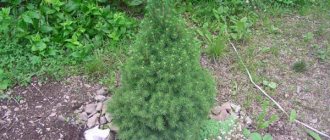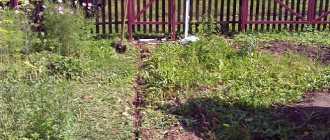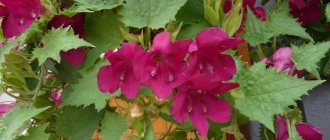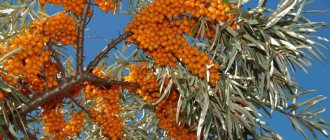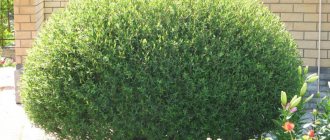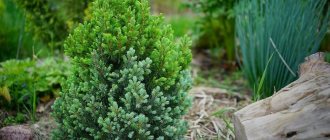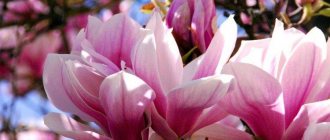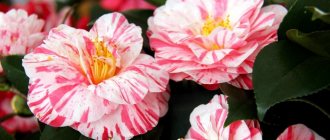10735
Evergreen coniferous plants look presentable both in the summer heat and in the winter cold, so owners of suburban areas always try to purchase them. Canadian spruce Konika is a favorite conifer, which has become popular due to its dwarf forms and fluffy branches. This long-liver can grow in one place for up to half a century, so even great-grandchildren will have time to admire its beauty and solidity.
Canadian spruce Konika Blue
The miniature tree is valued for its beautiful cone-shaped crown, which does not require additional shaping. If you look at photos in catalogs, you can clearly see what a colorful look a Christmas tree creates in the garden at any time of the year. It combines with many plants, but also looks decent alone.
Description of the species
It is difficult to grow a full-fledged coniferous tree on a plot, especially when it is small, but this statement does not apply to Konika. Its decorative value lies in its small size, regular cone-shaped crown and bluish shade of needles. And this is not all the positive aspects of the evergreen plant.
External characteristics of wood
Under normal conditions, the average height of Konika is about 2 m, and in a favorable climate - 4. This makes the tree universal. It can be used both for planting on the site and for home container growing.
The diameter of a middle-aged spruce is 2 m. The tree looks lush and voluminous. Konica can grow for about 300 years. At the same time, her growth is very slow. The first decade of Konik's life increases by a maximum of 10 cm every year, but after this development slows down significantly and amounts to up to 3 cm annually. Then this figure is halved.
Soft spruce needles are not dangerous for small children and curious animals
The crown shape, which forms a pointed cone, is not the result of careful management. The tree takes on this appearance naturally.
The crown of the spruce is dense and rich. The needles are green-gray, the needles are short, up to 1 cm in length, completely non-thorny. Cones are rarely present on the tree. They are oblong in shape and about 6 cm long.
The root system is superficial, like many representatives of conifers, so when planting, replanting and loosening the soil in the tree trunk circle, care must be taken, trying not to damage the horizontal roots located in the top layer of soil.
What is interesting about dwarf spruce?
Konica is a form of Canadian spruce that arose due to a natural mutation in nature. This species was discovered in Canada at the beginning of the 20th century, from where it spread to Europe and became the main decoration of household plots. In gardening there are other names for this species:
- Spruce Glauka Konika is a long-liver among trees. It can grow in one place for up to 300, and sometimes up to 500 years. It features soft, pleasant-to-touch needles.
Split cones on a gray Konika - Gray Conica (Picea glauca Conica) with pale blue needles grows annually by 4-6 cm. The crown is dense, cone-shaped, with a diameter of up to 1.5 m. The plant is light-loving, but also successfully takes root in partial shade. Ideal for planting in parterres, stone gardens, and at the front entrance. Flowering begins in late spring. There are many cones on the shoots, their length is from 3 to 8 cm. In the USA and Canada they are grown for timber industry. The wood is used to make stairs, kitchen furniture, and pianos.
- White Conica (Picea alba) is native to eastern North America. At the age of 30 it reaches 10-15 m. In a young seedling, the shoots are slightly raised and arranged regularly. The needles are bluish-green, up to 1.8 cm long. Grows on sandy, clay and moist soils.
From the description given, without looking at the photo, we can conclude that the listed conifers have an unusual color of needles and a presentable crown.
Growing conditions
All varieties of decorative spruce Konika grow well in various regions of Russia. They are winter-hardy, can withstand frosts of more than 30 °C, and are unpretentious to soils. Plants have the following characteristics:
- They prefer to grow in an open, bright place. They require some afternoon shade to protect the plants from sunburn, especially in early spring when solar activity is high and during the heat of summer.
- The tree is afraid of wind and drafts, as well as groundwater. Stagnation of moisture can provoke soaking of the root system, rot and death of the spruce.
- Konik does not like cramped spaces either. Therefore, you should not plant it between large trees, which will suppress the already slow growth and prevent the plant from demonstrating all its decorative properties.
The tree will also grow in the shade, but the color of the needles will fade and the decorative properties will be significantly reduced.
The popularity of Canadian spruce in our country is not as high as that of the prickly variety known as blue spruce. But under different names - gray, white - these plants are increasingly grown in Russian private farms.
Spruce Glauca conica: botanical description of the plant and optimal conditions for growing
Canadian spruce, gray spruce, glauca conica - all these are names of the same species. Under natural conditions, the height of this tree is about 20-30 meters. It is characterized by a dense cone-shaped crown, the diameter of which, under favorable growth conditions, can be over 1 meter.
The lifespan of this tree in some cases can exceed 300 years. Typically, the branches of young spruce trees are directed strictly upward, but during the aging process everything changes and therefore older specimens of these trees are distinguished by branches directed downward.
The needles of this species have a bluish-green color and a light aroma of blackcurrant leaves. At the moment, over two dozen species of this tree are known, most of them were bred artificially.
Reproduction
Adult Konica can be propagated in two ways - cuttings and seeds. Both options are quite lengthy and to obtain a young, grown seedling, especially from a seed, you will have to wait patiently for several years.
Nevertheless, these methods are used by amateur gardeners. They experiment with seeds of various plants and their generic characteristics.
Seeds
The Konika spruce has one reproductive feature - only a few seeds from a cone can inherit the decorative characteristics of the mother tree. Therefore, growing a plant in this way is a kind of lottery. Even if the seedling sprouts and begins active growth, it may not be decorative enough.
To start growing Konica from seeds, you need to take a well-ripened cone in the fall or winter and prepare the soil.
The substrate for it must be nutritious and have a high acidity level. To make it, peat, turf layer, leaf soil and purified sand are mixed - all in equal parts. The sowing depth is 1 cm. The container is placed in cool, close to natural conditions, and seedlings can emerge in the spring.
The germination of Konica spruce seeds is good and the long-awaited seedling appears in almost 100% of cases
Within a year, the seedling, with proper and proper care, will grow to a maximum of 20 cm, but will not yet be strong enough to be transplanted into unprotected soil.
Konica is often grown in home gardening for several years, and only when it reaches a height of 1 m or higher is it planted outside.
Cuttings
This method is used more often than seed propagation and has better results in terms of survival rates. A plant from a cutting will have 100% maternal decorative characteristics. But the process is slow - to obtain a seedling suitable for soil that does not have a protective coating, it will take several years.
It is recommended to grow Konica from cuttings not indoors, but outdoors, in order to create growing conditions that are closest to real ones.
A seedling from a cutting can be planted in a specific outdoor location in 3–4 years.
Cuttings are carried out in June so that the rooting process occurs in the fall. The cut of the cutting is overgrown within 2 months, and by September it can begin to take root, which should take root in the soil before winter.
Cutting and planting process:
- For cuttings, the lower branches of the mother tree, about 12 cm long, are cut off. Be sure to separate them with the “heel” and part of the bark from the trunk, otherwise they will not take root.
- The prepared planting material is placed in a solution from “Kornevin” and kept for 2 hours.
- A substrate is prepared - exactly the same composition as for sowing seeds.
- The cuttings are buried 2.5 cm into the soil, watered with a diluted Kornevin solution and sent to cool and humid conditions or left in a greenhouse if grown outside.
- In hot summer, plantings are ventilated and shaded.
Choosing a landing site
When choosing a place to plant, you should consider the size of the tree. The selected area should be well lit by the sun; in the shade the spruce will get sick and may die. Even partial shade often leads to curvature of the tree crown. It is not advisable to plant Konica in windy places.
When choosing a place to plant a tree, you must remember that this variety does not tolerate polluted air. It should not be planted near busy highways - the delicate decorative spruce will lose its attractive appearance and dry out.
The soil at the intended planting site should be loose and fertile.
How to plant
The fastest way to get one or more evergreen coniferous trees on your plot is to place high-quality seedlings purchased from a nursery.
Buying a seedling
Before purchasing and planting, you need to carry out a number of activities - find a suitable place that meets the conditions for good growth, prepare the soil.
It is best to buy a plant in a nursery, where there is a guarantee that they will sell you exactly the desired variety and the tree will not be sick
The selection of seedlings is carried out according to the following rules:
- It is better to purchase a specimen that has a closed root system. It can be dropped off at any convenient time.
- If you buy a bare-rooted seedling, you should not subject it to long-term transportation. Such material must be planted immediately.
- Be sure to pay attention to the condition of the root system. Even when open, there should be a full-fledged earthen lump on it.
- During transportation, it is necessary to cover the exposed roots with damp burlap or protect them from possible damage in another convenient way.
- A thorough inspection of the purchased seedling is required to ensure that it does not have dried, diseased branches or damage.
Selecting a location
It should be sunny; the tree will not grow well in the shade. Do not plant the plant in the wind or draft.
Konica is an actively “breathing” plant, so it tolerates air pollution very poorly. For planting in urban areas, especially near busy highways, it is worth choosing another representative of conifers.
The location chosen on the site for planting the spruce also depends on the desired landscape composition
There are many options for using Konica in garden design and they involve both single and group or border planting.
Recent Entries
Chainsaw or electric saw - what to choose for the garden? 4 mistakes when growing tomatoes in pots that almost all housewives make Secrets of growing seedlings from the Japanese, who are very sensitive to the soil
The land in the intended square should be fertile and moderately acidic. Enrichment with organic fertilizers in the previous planting season is encouraged. Before placing the plants, the soil is carefully dug up to a state of moderate looseness. The substrate should allow good penetration of not only moisture, but also air to the roots.
Planting process
You can plant spruce outside at almost any time of the year, except winter. In the spring and autumn seasons, it is permissible to place a tree in open ground whose root system is not protected, and in the summer only seedlings with closed roots can be used.
Konica's roots are thin and do not tolerate the influence of dry hot air, so if you plant the plant in the heat with open roots, it may dry out
Stages of planting:
- At the bottom of a prepared hole of the required size, drainage is poured with a layer of about 5 cm.
- A mixture of peat, leaf soil, turf, sand with a slight addition of organic matter is prepared.
- A small mound is formed in the depths of the hole, on which the seedling is placed.
- The roots are carefully straightened and the hole is filled with prepared soil with the addition of complex fertilizer.
- A circle around the trunk is formed, which will facilitate watering.
- Immediately after planting, 12 liters of settled water are poured under one seedling.
- The tree trunk circle must be mulched with clean peat, wood chips or middle fractions of tree bark.
Video: planting spruce in open ground
Planting and care
Canadian spruce Konica is unpretentious and hardy, but proper planting and care nuances will significantly extend its healthy life and decorative appearance. When choosing a site, you should take into account its low resistance to dust and pollution. It is not recommended to plant plants within the city or along roads.
Where to plant Konica
Norway spruce has a positive attitude towards the sun, but is afraid of the harsh rays of spring - soft, sensitive needles get burned, and the regeneration process is delayed. It tolerates light shade well, but the density of the crown may suffer. The ideal place for planting is an open, unventilated space on the sunny side of the site with fertile, moist soil. Confinement to trees or buildings puts Konika at risk of disease.
The density and splendor of the crown depends on the composition of the soil. Fertilized humus loam with a pH of 4-5.5 contributes not only to the decorative qualities, but also to the longevity of the plant. Konica spruce will also grow in any soil, but care should be taken to ensure breathability and sufficient moisture.
When to plant
The favorable time for planting or transplanting Glauca seedlings into the ground depends on the climatic conditions of the region. In central Russia - in spring, at the end of April or beginning of May. During the summer, the tree will take root well and become stronger if it is watered regularly. In the fall, early September is also a good time to root before frost, especially if the fall is rainy. The roots can accumulate enough moisture, and the cooler, more humid autumn air will help the plant adapt faster.
Solar spring rot on coniferous trees. Coating with a special material will prevent problems
Close-rooted specimens can be planted at any time during the growing season, but cool soil favors healthy rooting.
Selection of seedlings and planting algorithm
Basically, Canadian spruce Conica is sold in containers. Pay attention to the vase. For a good plant, the diameter of the pot corresponds to the circumference of the crown, since its roots are powerful and take up a lot of space. In a small container they will be squeezed - their suction roots die and rooting becomes difficult. Juicy, healthy greenery and a large vase are the criteria for choosing a seedling.
Before planting, carefully soak the Conica pot in water to avoid damaging the roots of the scion when removing it from the pot. The tree will be planted at root ball depth. If the root system is open, the root collar is at surface level.
Planting algorithm:
- At the planned planting site, the soil is dug up 15-20 cm deeper and wider than the size of the flowerpot so that the roots can spread freely.
- The soil is enriched with humus, acidic peat, and superphosphate.
- The planting hole should be the same height as the flowerpot, but wider so that the roots can be covered with soil.
- After removing the seedling from the flowerpot, place it in the hole.
- The free space is filled with soil and compacted.
The soil is thoroughly watered and mulched. Peat, pine sawdust, and softwood sawdust are used as mulch. This material helps maintain soil acidity.
Nuances of care
The peculiarity of Glauca is that it requires a minimum of attention. Hot and dry weather requires irrigation with crown sprinklers. This is done late in the evening. Remove weeds from the root ball in a timely manner and at the same time scarify the surface. The conic does not need to be formed, but pruning is carried out every year in the spring. Easy to trim.
The best time for pruning is early spring (March/April). To prevent fungal infections, treat cuts with a garden-safe fungicidal ointment.
To protect delicate needles from spring solar aggression and severe frosts, they need to be covered. All kinds of covers, matting or other material wrapping are used. The protection is designed to diffuse sunlight, but does not interfere with ventilation.
An important step in caring for Konica spruce is maintaining the nutritional value of the soil. Excess nitrogen is harmful to conifers. Potassium, magnesium and phosphorus are the main minerals that should be included in fertilizers. Nitrogen is also necessary, but in small quantities.
In the spring, 3 to 5 kg of humus is added to the root zone, gently mixing it with the top layer of soil. In autumn it is fed with a phosphorus-potassium mixture. Mulch with a 5-10 cm layer of peat, which is also added to the soil in the spring. Special additives for coniferous trees also saturate the soil with minerals.
How to care for Konica spruce
A coniferous tree does not require such tireless and careful care as garden crops, but it still needs to be given attention occasionally and cared for correctly so that it does not die and shows all its decorative properties.
Seedling care: table
| Care event | Description |
| Watering | The tree will need watering twice a week. Each time, 10 liters of water are consumed for one specimen. Konica loves sprinkling, so in the summer you can spray it weekly with a shower hose or watering can. It is important to ensure that the root system is not constantly wet to avoid rotting. |
| Loosening | This procedure is necessary for the seedling so that the roots can receive enough air. It is important not to loosen deeply, since horizontal shoots are close to the soil surface |
| Mulching | From time to time, the mulch poured during planting must be changed or topped up to provide the roots of the seedling with an optimal moisture regime and protect it from weeds |
| Shelter | It is necessary to protect the plant not only from frost in winter, but also from bright sun in summer. During the warm period, shading is provided - during the hottest hours, the seedling is completely wrapped in cardboard or burlap. In winter, the crown of the tree is covered with spunbond, and snow is poured under the trunk. |
| Top dressing | If organic matter is added during planting or complex fertilizers are applied, then fertilizing is not carried out in the first four months. In the future, it will be carried out in all seasons except winter. Fertilizing is carried out every two months with organic matter diluted in water. |
| Trimming | Konica belongs to varieties that do not require decorative pruning. Its crown naturally has a regular conical shape. But damaged or dried branches must be selectively removed as they appear, using sanitary pruning |
Diseases, pests and their control
This tree is susceptible to numerous diseases and pests, not to the same extent as other ornamental and fruit plants, but it will still have to be protected from several diseases, and treated when the first signs appear. These include the following ailments:
- Tracheomycosis. The seriousness of this disease is evidenced by the lack of resuscitation measures and the recommendation of gardeners to immediately, in order to avoid spreading to other specimens, dig up the tree, carefully removing all its roots, and burn it away from the site. Tracheomycosis cannot be cured. If it hits Konika, the tree will have to be destroyed.
Signs of tracheomycosis are redness of the entire crown covering and total loss of needles
- Rust. This disease can be dealt with if you notice its signs in a timely manner. When branches rust, orange growths form. The needles gradually begin to turn yellow, dry out and fall off. You can cure a tree with Vectra, using it according to the instructions.
- Schutte's disease. A sign of infection is a whitish coating on spruce needles. The tree must be sprayed with copper sulfate to fight infection.
In the later stages of Schutte's disease, the base of the needles turns black and they fall off
- Bark beetle. A pest that can spoil a tree if it gets into it. There are no destruction measures; only preventive methods can be used by spraying the plant with insecticides. The bark beetle attacks weakened and diseased trees, so it is necessary to ensure that the seedling is healthy and fully developed. If most of the plant is affected by the pest, then it can no longer be restored; it is dug up and burned.
- Spruce moth. An unpleasant parasite that penetrates under the bark and feeds on tree sap. A sign of its appearance is the sudden and abundant shedding of needles. To combat the parasite, the drug “BI-58” is used.
Diseases and pests
The Canadian Konica spruce, like all plants, develops diseases due to improper placement, agricultural practices, and lack of attention. If a red coating appears on the branches and the needles fall off, this is tracheomycosis, which affects the roots of young trees. The disease cannot be cured. Dangerous for surrounding plants. There is no treatment. The tree is burned along with the roots, and the place where it grew is treated with a fungicide.
Pine needle rust is a fungal disease. The signs of the disease are clear and easily distinguishable: small 0.5 cm orange growths (spore carriers) appear on the bark of the shoots. After some time, the needles turn yellow and fall off. Treatment: spraying with copper-containing preparations. Treatment is carried out several times during the month. It is not recommended to plant pome fruit crops next to conifers: apple tree, pear tree, as they are an “incubator” for rust spores.
An equally dangerous fungal disease is Schutte. It occurs from stagnant moisture in cramped and weed-filled plantings. It appears in early autumn as drying, yellowing of the needles with barely noticeable brown spots. The following spring, the needles turn black, become covered with plaque and fall off, becoming a source of infection. Treatment: fallen pine needles, cut diseased branches are burned, treated several times with fungicides or copper-containing preparations.
Glauka often suffers from root rot, which occurs from stagnant moisture in poorly aerated soils. By mid-summer the plant looks depressed, growth growth is poor. The tree is dug up, the damaged softened roots are cut off, and transplanted to a new, more favorable place.
There are several dozen insect pests, some sucking and gnawing: aphids, scale insects, false scale insects, mealybugs, spider mites and others. They are difficult to notice as they are very small, but cause great damage by sucking juices from bark, pine needles or roots. A visible sign is a sticky coating on the vegetative parts. Pest control includes mechanical and chemical methods. Preventive spring treatments with insecticides are an effective remedy. Preparations: Pinocid, Extraflor (garlic based).
Colonies of scale insects. Trees growing in the shade and on dry soils suffer. Spraying with the insecticide Actellik, Aktara, Bitoxibacillin will help get rid of the pest.
Growing at home
Many people want to have their own Christmas tree at home, and a live one, not an artificial one. Konica is suitable for home growing if it is properly cared for.
When buying a potted coniferous beauty on the eve of the New Year holidays, it is worth keeping in mind that it is not intended for long-term cultivation. After a maximum of a few weeks, 90% of such trees dry out and die in the hot and dry conditions of the apartment.
In winter, Konika, like all conifers, needs coolness. The plant is in a period of hibernation, so if you want to preserve the potted specimen you bought for Christmas, you need to provide it with optimal conditions.
Konica is by no means a houseplant, its biorhythms are natural and it is difficult to adapt to life in an apartment
First you need to find the coldest place in the house for the tree. This could be a northern window sill, the space between double frames, a loggia or a glazed balcony.
It is worth bringing the tree into the warmth only for a short time during the holiday. And under no circumstances should you spray it with floral sprays, artificial snow or other “decorations”.
After the holiday, Konika goes back to a cool place and remains there until spring. For the crown, the sub-zero temperature of an unheated balcony is not scary. The pot, especially if the soil in it is wet, will have to be wrapped in burlap or insulated in some other way.
If you choose a cool place in a room with central heating, you need to install a humidifier next to the plant or spray the crown several times a day and place a bowl of water next to it.
Transplanting from a shipping pot and substrate, if the tree was purchased in winter, is best done in spring
Watering should be carried out, but not abundantly and occasionally. Water at room temperature that has stood for several days is suitable. It is better to mulch the soil in the pot.
Direct rays of the sun are undesirable for the tree. If the location is chosen on the windowsill, it is necessary to create shading at noon, especially in February - March. But the plant needs light for the health of the needles, so the pot can be turned with the other side to the light source every week.
A free pot or container is selected for transplantation. Filled with a mixture of peat and sand, leaf soil and turf. Complex fertilizer is added. The tree is carefully rolled into a new pot along with the lump.
In April, you can start feeding, take the plant out into the fresh air and even replant it in open ground, if such a need arises.
In the open ground
Dwarf conifers are often used to decorate garden plots. Konica is planted singly or used to create complex compositions: flower beds, rock gardens, rockeries. This species does not take root well in contaminated areas; spruce can only be planted in suburban areas.
Planting in the ground is carried out in the spring. Choose a cool, cloudy day, early in the morning or in the evening.
Choosing a spruce seedling
You need to buy a tree only in special nurseries. The younger the tree, the greater the chance that it will take root. If you managed to save a seedling bought in a store, plant it for the New Year:
- The crown is bright, without yellowness or bald patches.
- The root system is healthy, without damage or rot. Select specimens with closed roots (with a clod of earth). This spruce will take root easier. The roots should tightly entangle the soil.
- The branches are elastic.
Preparing the site
Choose a lighted place, protected from drafts and direct rays of the sun (near buildings and fences). The plant prefers well-drained, loose, slightly acidic soil (loam is ideal). It is best to bring soil from a coniferous forest; the acidity increases with the addition of peat. Flower shops offer ready-made soil mixtures for conifers.
Another cool tree is Catalpa bignoniiformes. Read.
Prepare a hole twice the size of the earthen clod. Drainage is poured onto the bottom (expanded clay, gravel, brick chips). The root system does not tolerate stagnant moisture and the plant dies.
Suitable soil is made from the soil of a coniferous forest and a special substrate purchased in a store.
Planting stages
Spruce does not tolerate frequent transplantation. You need to carefully prepare the place and follow the planting rules:
- The plant is taken out of the container.
- Immerse the roots in water at room temperature for 1-2 hours.
- In the planting hole, make a hill of soil and place a seedling on it. The soil around the roots is preserved.
- The hole is filled with fertile soil and lightly compacted.
- Abundantly moisturize.
- If the soil has settled too much, add more and water again.
- Apply a layer of mulch under the bush (pine needles, bark, small branches, sawdust, crushed cones). Everything you need can be collected in the coniferous forest.
The root collar remains above the surface.
Seedlings younger than 4 years old do not require fertilizing during planting. The rest need nutritional formulas.
In the first 2-3 months after planting, the needles may fall off. This is a reaction to stress. After rooting, young branches will begin to grow.
Coniferous plants are very sensitive to fertilizing. They are suitable for special complexes corresponding to their species and age.
Use in landscape design
Konica is a tree loved by landscape designers for its bright and outstanding decorative qualities . The crown does not need to be cut; it grows slowly. Spruce can be used for both group and single plantings, as well as forming green hedges.
Design options:
- Solitaire planting. It can be carried out both in open ground and in a pot, which is placed in a certain place. The second option is preferable because the location of the tree can be changed depending on the preferred design.
- Hedge. Konica is the best plant for these purposes among all conifers, since there is no need for careful care of the crown. When planting a hedge, it is worth considering that the diameter of a medium-aged tree is 2 m. Dense plantings can lead to crown diseases and pest damage.
- Use in garden compositions. The correct, neat crown cone of Konica looks great in rock gardens and rockeries, and also serves as a noble background for beautiful flowering plants.
- Decoration of an entrance or window group. Konica is often planted in duplicate on both sides of the front door or large window.
- Symbol of the New Year. Spruce can be used as a holiday tree. When growing in containers, it can be brought indoors for a short time, and if it is in open ground, it can be festively decorated right in the yard.
Decoration methods: examples in the photo
Ephedra goes well with a variety of flower arrangements.
Konika spruce looks good as a hedge
Ephedra can be an interesting way to decorate the front entrance to your house.
You can select various combinations of coniferous trees and shrubs depending on the landscape
Miniature Konika spruce will be an excellent holiday decoration
Spreading
In its natural habitat, Glauca is found in the habitats of its ancestor, picea glauca, in the forests and foothills of Canada from Labrador to Alaska, where it was discovered in 1904 on the shores of Lake Lagan. An unusual, long-lived plant, in the wild it grows up to 5 m in height. The original shape of the crown, which does not require formation, and wind resistance contributed to the spread of this variety in other regions. It grows successfully in places where other spruce trees grow.
Koniku spruce was artificially bred in nurseries in the Netherlands, Holland and Russia for use in landscape design, interior decoration and as a windbreak. Koniku Christmas trees with soft, safe needles and a real spruce aroma are bought as gifts for the New Year.
Watering
When caring for Konik blue spruce, special attention should be paid to watering. Konica is very demanding about this issue. The main thing in this matter is that you should not over-water the root system , otherwise the spruce may die.
Watering should be moderate, but at the same time, the soil must always be kept moist . To do this, you can use various systems of communicating vessels that maintain humidity in flowerpots with evergreen bluish fir trees. It is also useful to choose compost that contains peat.
As for the hot season, it should be noted that maintaining soil moisture during this period of time needs to be taken more carefully. At this time, Konika spruce is most vulnerable. Therefore, flowerpots with this plant must be constantly kept in the shade , otherwise its needles may get burned in the sun. If you neglect this rule, you may end up with the needles falling off the tree.
To properly care for the Konica spruce, you need to know that simply watering the tree at the root is not enough. This spruce needs rain. Therefore, it should always be sprayed when watering. If this is not done, the spruce may lose its natural color and acquire unnatural shades that are not typical for this evergreen plant.
Loosening
After each watering, you must not forget to loosen the soil around the tree trunk. This must be done very carefully so as not to damage the root system, which negatively affects the “well-being” of the plant. This tree has a very “delicate” root system, which is very picky about its condition. It is easy to damage because it grows close to the soil surface.
You need to mulch the soil about once a week. It is not necessary to do this after each loosening, but you should not forget to do it. For mulching, it is recommended to use peat or peat compost. This compost is produced specifically to prevent the soil from drying out. You can buy it at any gardening store.
Breeding Konica
Planting the gray Konica spruce does not require much knowledge in this area. The main feature in these matters is that you can grow spruce at home . This tree grows for a very long time, regardless of whether it is planted in open ground or in a pot. A seedling of this spruce grows to only 6-10 centimeters in 10 years . Therefore, you need to be patient and be prepared for the fact that this tree will grow for a very long time and its height will be low for many years. Konica is bred mainly by cuttings, but it can also be done using seeds. Both of these methods take a lot of time, so the first sprout will not appear soon.
If this tree is grown using seeds, then it, as a rule, loses almost all the characteristics of coniferous spruce. Planting and care, no matter how good they are, cannot help here. The spruce may even begin to grow not in height, but in width. Therefore, almost no one uses this method to plant spruce. Only two seedlings out of a hundred will be similar to the mother coniferous tree plant. To propagate Konika spruce in this way, seeds must be collected from well-ripened cones. If the seeds are collected earlier, then all the seeds will die and will not bear fruit. It is recommended to plant in flowerpots (pots). There is no need to deepen the seeds. One centimeter is enough.
If the cultivation of Konica is carried out using cuttings, then more positive results can be expected, in contrast to the seed propagation method. An adult seedling, about 10 centimeters high, already has a regular triangular shape. That is why this method is more attractive to gardeners. However, this method takes much more time.
Regardless of which method of planting this decorative spruce is chosen, after the seedlings have grown, the flowerpots should be moved to a cool place. In addition, so that the midday sun does not fall on them. Experts recommend choosing a location that best suits natural growth conditions.
If the method chosen for growing this tree is cuttings, then you need to know that this is done at the beginning of summer. If you start this business in the fall, then you may never get seedlings, since this ornamental woody plant does very poorly during the heating season.
For cuttings, you should
choose the youngest and most “live” branches . You can also purchase seedlings in special nurseries. If you decide to buy seedlings in a special nursery, you need to be careful when choosing a seedling. When choosing, you should ask the seller how this or that seedling is propagated. This must be done so as not to accidentally buy a cutting that grew from a seed. It may happen that a seedling grown from a seed may subsequently lose its correct shape, lose its unique color and its decorative effect.
The main diseases of spruce trees: what causes them
Diseases of spruce needles and shoots are dangerous for young plants. A sick tree spends most of the products of photosynthesis on the formation of protective substances, rather than on growth, and with a chronic disease the tree is greatly weakened. Follow some rules:
1. The nature of spruce diseases is damage by pathogenic fungi. Take a closer look at the damaged tree to diagnose and take timely measures.
2. Spruce trees are very rarely damaged by rust and shutte. Norway spruce, Siberian spruce, Canadian spruce, and Engelmann spruce are susceptible to these diseases. The description of these diseases and control measures are almost identical to pine, look in this material >>>>
3. Don’t rush to cut down affected trees or write them off as dead. Give them some time.
4. It is important to note that fungicidal treatments only protect new growth. It may take two to three years of annual fungicide applications for control to be completely successful.
5. For ulcerative diseases, the effectiveness of fungicides is usually limited. Removing affected branches will be the best solution to improve the appearance of the tree and slow the spread of disease within the tree.
Fusarium spruce
How to plant a spruce seedling
How to plant a Konika tree correctly to minimize its stress? Planting a spruce is an important point on which the development and appearance of the tree in the future depends.
The following recommendations should be followed:
- Konica should be planted in May to prevent the last insidious frosts;
- The planting hole should be prepared in advance. Place a drainage layer at the bottom, on top of which add a nutrient layer of peat, leaf humus and sand. Also add some mineral fertilizers such as Zircon or Epin to the pit;
- then the pit is watered abundantly.
Then the seedling with a clod of earth is moved there (a gentle transfer method), the soil around the planting is carefully compacted and watered again. Next, the trunk is covered with a small layer of mulch.
After planting, it is recommended to shade a fragile Christmas tree with non-woven material to avoid drying out the soil and causing sunburn.
